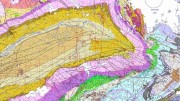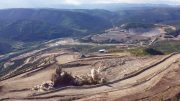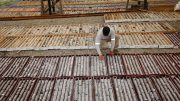VANCOUVER — For the past four decades, the theory of plate tectonics has remained a fixture in every geologists understanding of how the earth’s crust glides across the planet and subducts beneath the continents. But what if the early Earth, circa 3.2 billion years ago, was just too hot for plate tectonics to work?
A recent study published in the journal Nature has added weight to growing evidence that the Earth’s first continents didn’t form by subduction — the process of ocean crust diving underneath continents, melting and creating a chain of volcanoes. Rather, they may have formed from the partial melting of abnormally thick ocean crusts that developed under the extreme temperature conditions of ancient earth.

A 3.5-billion-year-old stromatolite sample, extracted from the oldest known definite
fossil occurrence on earth in Western Australia’s Pilbara craton. Photo by James St. John.
All this may be relevant to mineral exploration, considering many companies are exploring in rocks older than 3.2 billion years, looking for orogenic gold and magmatic nickel-copper deposits. Being reminded that the magmatic and tectonic regimes were possibly different back then may help fine-tune their exploration models.
Nicholas Gardiner, a research fellow at Western Australia’s CET-Curtin University, and one of the authors of the paper “Earth’s first stable continents did not form by subduction,” spoke with The Northern Miner via Skype from his office in Perth, Western Australia, to share details of the group’s findings.
“Plate tectonics is an expression of the Earth trying to lose heat, the heat being generated by radioactive decay within the Earth’s lower mantle,” Gardiner says. “Over 3.5 billion years ago, the gradient of temperatures at the surface of the Earth to the top of mantle was probably 200 degrees hotter than today. So if you had a hotter Earth, you can expect a lot of melting.”
As the Earth began to cool after its initial accretion 4.6 billion years ago, he continues, increased volcanism may have covered parts of the planet with 50 to 70 km thick slabs of ocean crust.
Gardiner and a team of scientists collected samples from basalts at the base of one of these “stagnant, basaltic plateaus,” in Western Australia’s Pilbara craton — one of the oldest vestiges of Earth’s initial crust — and subjected them to a variety of pressure and temperatures.
They discovered that elemental signatures in the melts generated from the test were the same as signatures found in granitic batholiths also seen in the Pilbara. Together, the package of rocks is known to geologists as “greenstone belts.”
“The high geothermal gradients on early Earth may have triggered partial melting at certain depths within these oceanic plateaus, generating granitic magmas,” he says. “In the Pilbara, you see a distinct pattern of greenstone belts surrounding ovoid-shaped granites. So initially you had an eruption of greenstones as basalts, and a doming episode where the granites rise and the greenstones sink because of differing densities — a process some call ‘sagduction.’”
By 3 billion years ago, temperatures on Earth may have cooled enough to sustain modern-day plate tectonics, and the volcanic terranes began to accrete together, forming the nucleus onto which more modern crust could attach. These younger greenstone belts are more prolific within Western Australia’s Yilgarn craton, south of the Pilbara, and are known to host considerable reserves of gold.

Geology map of Western Australia. Archean-aged Pilbara craton (north) denoted as darker greens and reds, versus the Yilgarn craton (south) denoted as lighter pinks and greens. Credit: Department of Mineral and Petroleum Resources, government of Western Australia.
“In the Yilgarn you don’t have granitic domes like what we see in the Pilbara: you have continental volcanic terranes that were accreted together, so the pattern of the greenstones is different,” Gardiner says. “The gold was introduced 2.7 billion years ago, during a period of mountain-building that’s more consistent with modern-day theory of plate tectonics.”
Archean-aged crust similar to the Pilbara and Yilgarn cratons are also found in parts of South Africa, Greenland and over much of Canada. In Canada, the most prolific greenstone belt is the 150 million oz. gold Abitibi belt that spans the Quebec and Ontario border. Like the Yilgarn, gold in the Abitibi was emplaced 2.7 billion years ago in a setting more in tune with modern-day plate tectonics.

Global distribution of Archean-Proterozoic cratons. Credit: USGS.
“It’s a controversial topic; we’re just adding to one side of the debate. There are people working in Greenland that are convinced modern subduction occurred 3.7 billion years ago, but there’s no reason why on one side of the planet you could have plateaus like we’re proposing, and the other side have active subduction. It’s not like everything changed over one Tuesday morning at 9 a.m.,” he says. “Different parts of the planet are pointing to different lines of evidence, so it does get confusing … but it’s healthy to keep the debate going.”






Hmmmm, sounds remarkably similar to what Univ. Of Western Ontario Professors were teaching In the 1980s, including Dr. Richard Hutchinson at CSM